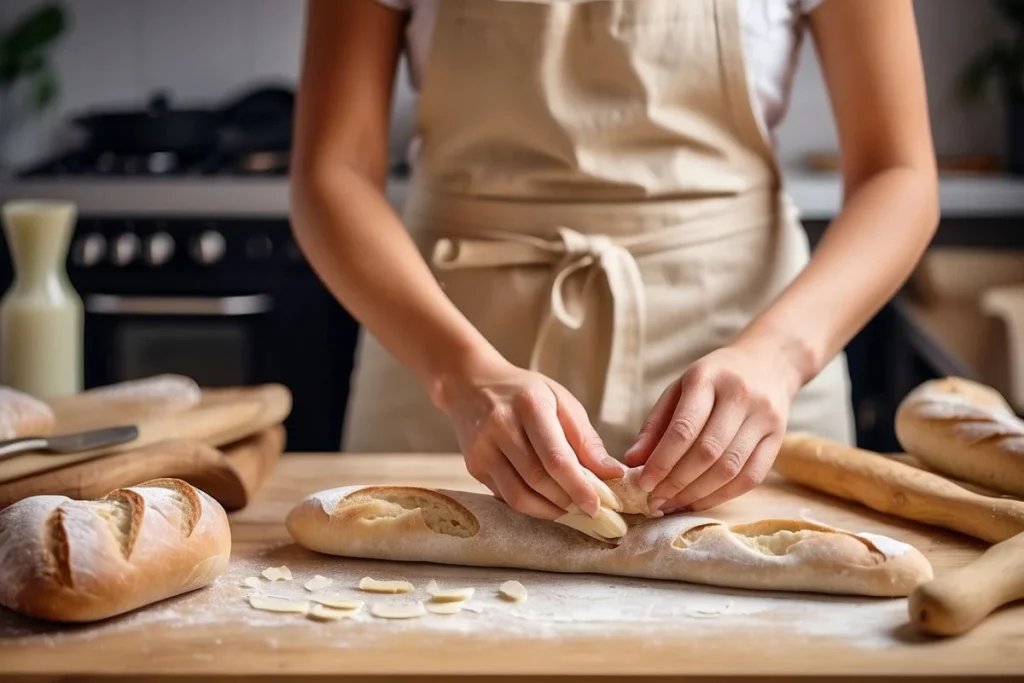
How To Make a Baguettes without a Baguette Pan
Are you craving the crusty and delicious taste of freshly baked baguettes, but don’t have a baguette pan on hand? Not to worry! In this article, I’ll guide you on how to nail the homemade baguette game without needing a baguette pan.
I’ll also give you five alternatives to a baguette pan and some personal tips. Whether you’re an experienced baker or a newbie, our easy and fail-proof method will have you savoring perfectly crunchy baguettes in no time.
Table of Contents
ToggleWhat Does a Baguette Pan Do?
A baguette pan is a special tool made for baking those classic French baguettes, and it comes with some perks for getting that perfect loaf. Its long shape and little holes help spread the heat evenly, giving you a crunchy crust and a light inside—exactly what makes a baguette really French.
Plus, the pan has a non-stick surface, making it easy to take the bread out without it getting stuck. The pan’s design also supports the dough while it rises and bakes, helping it keep that long, lovely shape.
But if you’re not into using a baguette pan, don’t worry. Our guide will show you how to make this tasty bread without one. You can try out different methods and enjoy baking baguettes without being tied down to a special pan.
Common Issues When Making Baguettes without a Baguette Pan
Creating a baguette without a special pan can be a satisfying challenge, but it does come with its own set of difficulties. Understanding and tackling these common issues ensures a smooth baking experience.
Shaping and Structure
One of the main challenges in making baguettes without a dedicated pan is achieving the desired shape and structure.
The pan, with its long and holey design, plays a key role in guiding the dough during baking, resulting in the classic slim shape and a well-defined crust. Without it, bakers might find it tough to keep the proper form, leading to uneven shapes or flat loaves.
To overcome this, careful shaping techniques become crucial. Using a well-floured surface and employing the roll and fold method can help create the necessary tension in the dough, ensuring a more controlled and even rise during baking.
Practice and patience are key in mastering these skills.
Crust Development
The lack of a baguette pan can also affect crust development. The pan’s holes contribute to optimal air circulation, creating a crispy crust. When baking without a pan, achieving the same level of crustiness can be a challenge.
To address this, thorough oven preheating and steam generation are crucial. Preheating the oven thoroughly creates an environment conducive to crust development. Introducing steam during the initial stages of baking mimics the conditions of a professional bread oven, promoting a crisp and golden crust on the baguette.
Even Baking
Ensuring an even bake without a baguette pan requires careful attention to the placement of the loaves in the oven. Without the pan’s guidance, bakers must be mindful of potential hot spots and uneven heat distribution.
To mitigate this issue, rotating the baking sheet halfway through the baking process promotes uniform browning. Additionally, spacing the loaves appropriately on the baking sheet helps achieve consistent results.
Keeping a close eye on the oven and making these adjustments contribute to a successful outcome when making baguettes without a baguette pan.

5 Simple Alternatives for Making Baguettes without a Baguette Pan
Creating a tasty baguette without a fancy baguette pan is totally doable, thanks to a range of easy-to-find alternatives. These substitutes not only make up for the absence of a dedicated pan but also bring flexibility and creativity to the baking process.
1. Baking Sheet
Instead of a baguette pan, a regular baking sheet works just fine. Although it doesn’t have the long shape and holes of a baguette pan, a baking sheet offers a flat surface for the dough to rest and rise while baking.
To get that classic baguette shape, you can use a simple technique: roll and fold the dough into the desired elongated form. Placing the shaped dough on a well-floured baking sheet ensures even heat distribution, resulting in a delicious baguette with a golden-brown crust.
2. Parchment Paper or Kitchen Towels
If you want to improve the shape and structure of your baguette without buying a pan, parchment paper or kitchen towels are your friends. After shaping the dough, place it on a long, well-floured piece of parchment paper or a kitchen towel to help it maintain its form during rising and baking.
The paper or towel acts as a guide, letting the dough keep its shape through the final proofing and when transferred to the oven. This method is especially useful when working with wetter doughs that might spread during baking.
3. Baguette Couche or Linen Cloth
For a more traditional approach, using a baguette couche or linen cloth is an excellent alternative. A couche is a piece of floured linen or canvas designed to support baguette dough during its final rise.
By placing the shaped dough between the folds of the couche, bakers create a natural division, preventing the loaves from sticking together and aiding in the development of a uniform shape. When ready for baking, transfer the baguettes directly from the couche to the oven for a professional-looking result.
4. DIY Baguette Molds
For those who want to get creative, making your own baguette molds can be a game-changer. Use aluminum foil to shape cylinders that mimic the dimensions of a traditional baguette.
Place these molds on a regular baking sheet, and there you have it—your homemade baguette pan. The foil molds provide structural support during baking, helping the dough maintain its shape and rise properly.
5. Perforated Baguette Pan Substitution
If you’re aiming for that crispy baguette crust, consider using a perforated pan as a substitute. These pans, designed for optimal air circulation, mimic the effect of a professional baguette pan.
Place the shaped dough directly onto the perforated pan, allowing for even heat distribution and a golden, crunchy exterior. This alternative is an excellent choice for those who desire a texture close to what’s achieved with a traditional baguette pan.

Step-by-Step Guide to Making Baguettes without a Baguette Pan
Taking on the challenge of making baguettes without a fancy pan doesn’t have to be intimidating. In fact, it opens up a whole new world of possibilities and lets you get hands-on with your baking.
Follow these easy steps to whip up your very own tasty baguettes using simple alternatives.
- Step 1: Get Your Ingredients and Tools Together: Before you dive into baking, gather up your ingredients and tools. Grab some top-notch flour, yeast, water, and your essential kitchen gear. The type of flour matters, and having a good mixing bowl, measuring tools, and a kitchen scale will make things go smoothly.
- Step 2: Pick Your Alternative: Choose one of the three alternatives we mentioned earlier: a baking sheet, homemade baguette molds made from aluminum foil, or a perforated pan. Each option has its own way of shaping and baking your baguette. Consider your kitchen setup and personal preferences when making your choice.
- Step 3: Mix and Shape the Dough: Combine the ingredients to make a nice, elastic dough. Follow the guidelines for mixing and kneading properly. Once your dough is good to go, shape it into a log that fits the length of your chosen alternative. Whether it’s a baking sheet or a DIY mold, getting the right shape is key for a good-looking and tasty baguette.
- Step 4: Let It Rise: Give your shaped dough some time for its final rise. This step is important for developing flavors and achieving that light, airy texture that a perfect baguette is known for. Keep the temperature and humidity just right for optimal rising.
- Step 5: Heat Up the Oven: Preheat your oven to the recommended temperature, making sure it hits that ideal level for a golden, crispy crust. Getting the oven just right is crucial for your baguette success.
- Step 6: Bake Until Perfect: Put your shaped dough on the chosen alternative and slide it into the preheated oven. Bake it until the baguette has that lovely golden color and a crispy crust. Keep an eye on it since the time may vary.
- Step 7: Enjoy Your Homemade Baguette: Once your baguette is out of the oven and has cooled a bit, it’s time to enjoy the fruits of your labor. Slice it, butter it, or pair it with your favorite sides. The satisfaction of savoring a homemade baguette is unmatched, and the pride of making it without a fancy pan adds an extra layer of joy to the experience.

Tips for Shaping and Scoring Baguettes without Baguette Pan
As someone who’s tackled the challenges of making baguettes without the usual pan, I’m excited to share some super helpful tips that’ll up your baking game.
Shaping Tricks
- Roll and Fold Method: Start by shaping your dough into a rectangle. Roll it up tight, making a cylinder. To give your baguette a solid structure, tuck the ends under, keeping it all nice and even.
- Nailing Surface Tension: Getting that perfect baguette look relies on having the right surface tension. Gently stretch and lengthen the dough, making sure it’s tight on the outside. This not only makes it look good but adds to the texture too.
Scoring
- Sharp Tools: Get yourself a sharp, serrated knife or a baker’s lame for scoring. A clean, quick cut lets the dough expand just right in the oven, creating those cool splits.
- Angle Is Key: Hold your scoring tool at a 45-degree angle for the best results. This angle helps the dough expand in a controlled way, giving your baguette that classic shape.
- Get Creative with Patterns: Scoring isn’t just about function; it’s a chance to add some art. Try out different patterns, from a simple slash to more intricate designs. It’s your moment to make your creation unique.
My Own Experience: Figuring out how to shape and score without a special baguette pan might feel a bit tricky at first, but with some practice, it becomes a satisfying routine. I’ve discovered that each batch brings new lessons, and the little imperfections tell the story of my experimentation.
Final Thoughts
In summary, while using a baguette pan is convenient, making a perfect baguette without one is doable and satisfying. You can overcome challenges in shaping, developing a crust, and baking by using careful techniques like the roll and fold method and ensuring proper steam.
Trying alternatives like baking sheets, parchment paper, baguette couche, DIY molds, or perforated pans gives you flexibility and adds creativity to the process. Follow the step-by-step guide, and with patience and practice, you’ll become skilled at crafting delicious baguettes.
Each batch will tell a unique story of your baking experiments and successes. Take pride in savoring your homemade baguette – crispy and golden – without the need for a fancy pan. Happy baking!
Lindsey Mackenzie
About me
Hi there! I’m Lindsey Mackenzie, the founder of Bake Smartly. Baking has been my passion since childhood, growing up in my father’s bakery. With Bake Smartly, I’m excited to share my love for all things sweet and savory. Join me on this delicious journey as we whip up scrumptious treats and sprinkle joy into every bite!






